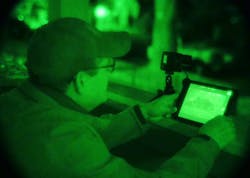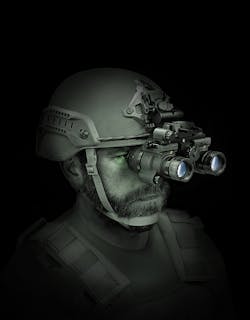White or Green – Have You Made a Choice Yet?
With many new products and updates rolled out every year, it is quite understandable if your budget can’t keep up. Or anyone’s budget, really. Getting the latest and greatest technology available has its own packaged issues. New technology trends tend to run expensive until the industry bounces back with a more affordable manufacturing process.
Then, of course, there’s the approval process and getting through the red tape for your own jurisdiction.
It helps when the technology in question has the potential for officer and community safety. Aside from that benefit, there are pros, cons, and differences between staying with the standard or changing over to a new technology.
With that in mind, let’s take a look at the differences between White Phosphor Technology and the traditional green. With any luck, the following may help you compare and contrast the capabilities to match your mission requirements.
The similarities…and differences
There are two big ticket items that need to be stated first and foremost. First, they both enhance available light to effectively allow officers to see low-lit areas. In other words, they’re both night vision. Second, one image intensifier tube produces a green-based picture while the other returns something more of a black and white or a gray scale of shades. If the need to see in the dark is the only requirement, you might as well skip to the price.
It seems the capability of the white night vision was only available once Gen 3 night vision technologies were around. The increased performance and resolution versus Gen 2 technology provides law enforcement officers and the military better detail and use in even lower light environments.
According to Harris, a leading manufacturer of night vision tubes, the color comes from the phosphor used in the tube. When a photon of light enters the tube it is multiplied and is affected by the color of phosphorus on the tube. The use of P45 phosphor screens creates the white image. P43 for green.
In one example Harris published on its website in April 2016, a sergeant had utilized his night vision devices to spot three subjects. The Gen 3 quality allowed him to identify they were armed with shotguns and handguns. Out-armed and out-manned he opted to stay safe calling for his backup to turn on the siren and lightbars causing them to drop their stolen items and flee. In the story, the sergeant contributes his survival that night to the night vision equipment.
While the story does not mention if the sergeant was using the traditional “green”, a number of users have reported an increase in contrast with white phosphor. Night Vision Devices states online, “this change in color has been reported to enhance overall object recognition while providing contrast sensitivity equivalent to or better than traditional green phosphor tubes.”
American Technology Network (ATN) concurs, stating “studies show that nighttime scenes appear remarkably more natural in black and white.”
They list their WPT specifications as:
- Resolution: 60 to 74 lp/mm
- Signal-to-noise ratio: 18 to 26
- Tube life: 10,000 hours
While researching the device to best fit your mission requirements, you should inquire about distance, blooming and gain adjustment. Various dealers, distributors and manufacturers may also offer different levels of warranty.
Night Vision Optics posts “you should be able to tell the difference between male and female figures at around 75 to 100 yards.” Ask yourself as you check out devices if it allows you enough resolution to recognize a shotgun at distance. They also suggest to not base your purchase on blooming alone. My suggestion: if it’s a concern, ask. Blooming is blooming, halo is halo. The color won’t avoid these effects from happening.
Some users report personal preference of green instead of white, despite the claimed technological advancements.
While the amount of time using the device was unclear, users mention that their eye/s adjust better back to the dark with the green color. However, others report just the opposite.
“We’ve done a lot of testing,” says Darrel Hackler, senior director of Global Business Development for Haris Corp. Night Vision. “There’s really no scientific evidence that one phosphor color is better than another phosphor color. It really comes down to user preference.”
With that, if there’s a difference in resolution, that may be cause from the night vision technology itself, not the color of phosphor.
The fact of the matter at hand is simple: want vs. need. The “need” is covered by both—provide a night vision solution. Both are readily available through a multitude of dealers, distributors and manufacturers. As such, both should be eligible for grant funding if that’s the financial avenue your department is driving down.
The final question is personal preference: Which color of night vision would you like to view the dark with? Hopefully this short piece helps to illuminate a few items to assist in making that decision.
Colorized Night Vision?
There aren’t only two options available for law enforcement. The company Chromatra LLC introduced ColorTAC three years ago, in 2014.
In their announcement, they write: “The ‘green glow’, monochromatic image denies the [night vision goggle] viewer critical visual information: color. This missing information can be a liability or even potentially deadly. Without the vital information that seeing color can provide, law enforcement personnel may not be able to properly access the scene and make correct tactical decisions; military medics have difficulty telling blood from water, oil or other fluids, and thus may make mistakes in triage priorities; troops can have difficulty navigating terrain; and seeing color can reduce the fatigue and visual distortion green monochromatic night vision can cause.”
They continue referencing a 2014 statement from Admiral McRaven, “being able to see color at night will help maintain our troops’ tactical advantage going forward.”
They continue explaining that users can utilize ColorTAC with any available night vision devices, such as attachable to the popular PVS-14 green or white phosphor devices.

Jonathan Kozlowski
Jonathan Kozlowski was with Officer.com, Law Enforcement Technology, and Law Enforcement Product News from August 2006 to 2020.
As former Managing Editor for Officer Media Group, he brought a dedicated focus to the production of the print publications and management of the Officer.com online product and company directory. You can connect with Jonathan through LinkedIn.
Jonathan participated as a judge for the 2019 and 2020 FOLIO: Eddie & Ozzie Awards. In 2012, he received an APEX Award of Excellence in the Technology & Science Writing category for his article on unmanned aerial vehicles (UAVs) in police work, aptly titled "No Runway Needed".





